U.S.A. -(AmmoLand.com)- The Century Arms AP5-P Core is truly incredible; not since the Second World War has the words ‘roller-delayed’ and ‘affordable’ been mentioned in the same sentence. (On a side note, don’t forget to check out my recent guide to affordable, quality MP5 magazines.)
Sound confusing? Keep reading.
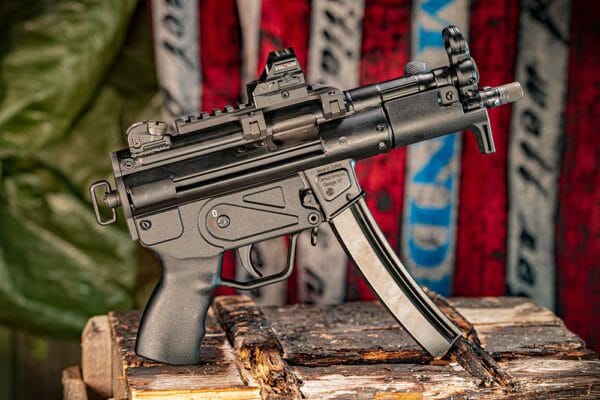
AP5-P Core Development History
Back in the final days of World War Two, the German military was in dire need of small arms like the MP-40, the STG-44, and the Mauser 98k. Except for the MP-40, all of these guns were expensive and time-consuming to produce. And while the 9mm MP-40 was cheaper, it suffered from limited effective range. So the engineers at Mauser decided to utilize the proven roller-delayed operation of the MG-42 and couple it with the intermediate-power cartridge, magazine design, and other design aspects of the STG-44.
The result was the Gerat 06: an inexpensive, effective (if somewhat finicky) assault rifle that, despite being fielded in very limited numbers, was an effective proof-of-concept for roller-delayed select-fire weapons.
But how was this cheap? The stamped receiver and rollers or wheels that are used to delay the unlocking of the action don’t require the fine machining or wasted material that guns like the STG-44 (MP44), Gewehr 41, Mauser 98 or FG-42 needed.
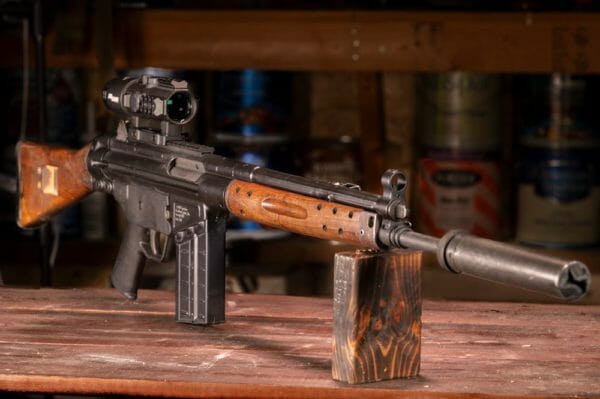
The design worked well enough that after the fall of Nazi Germany, many of the Mauser engineers took the design to France to develop a new weapon. This team eventually traveled to Spain to work on the CETME program, which resulted in a roller-delayed 30-caliber CETME Modelo 1 assault rifle. This design was further refined to meet the demands of West Germany’s Bundesgrenzschutz. Although it did very well in testing and saw limited adoption, it was passed up in favor of the Belgian FAL under the designation of Gewehr 1.
Thankfully for fans of Heckler and Koch, Belgium wasn’t comfortable handing over the rights to produce the FAL to Germany, so the military instead chose to adopt a modified CETME rifle under the new designation Gewehr 3 or G3. This roller-delayed, magazine-fed .308 battle rifle was an immediate hit, but security and police forces wanted something lighter. So in 1964, a handful of engineers at H&K modified the design to fit the 9mm cartridge and miniaturized the entire gun under the HK54 moniker.
Two years later, the German Border Patrol, Federal Police, and special forces adopted the gun with the new name, MP64, which later became known as the MP5.
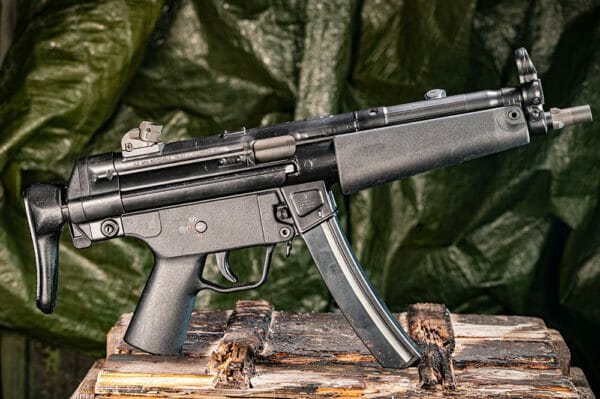
The new compact submachine gun was met with widespread acclaim for its accuracy, soft recoil, and diehard reliability – but some units still wanted a smaller, lighter version. In response, H&K further refined and reduced the design into the MP5K and later the MP5K-PDW – where it saw action on every corner of the globe. In fact, the gun was so well received that dozens of nations licensed the production of it (and other MP5 designs), including Turkey. That’s where our hero comes in – the AP5 P Core.
But given its relatively low price, many people wonder, “is the AP5 a good gun?”
Let’s take a closer look and find out.
Century Arms AP5 P Core Pistol – Under the Hood
The Century-imported AP5 P Core is a clone of the HK MP5K built on actual HK tooling by MKE of Turkey. If you skimmed over the history lesson above, the AP-5 P Core is a roller-delayed, magazine-fed pistol chambered in 9mm parabellum. It feeds from stagger-column detachable box-type magazines and ships with a 30-round version in the box. Shooters in search of either more capacity or a reduction in overall size can utilize any of the other MP5 magazines and drums available in 10,15, 20, 30, 50, and 100-round varieties.
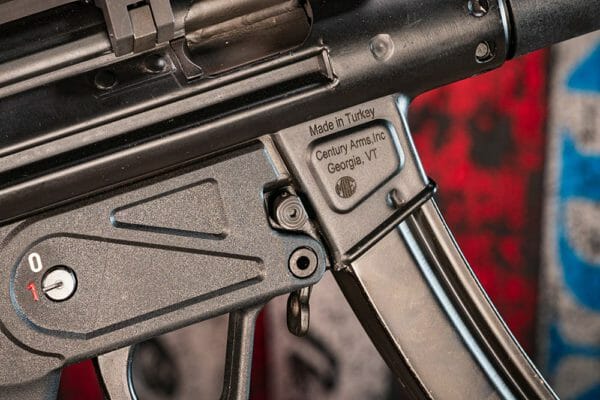
The AP-5 P Core is available in two varieties: one with a short barrel flush with the handguard and one extending an inch past it and features a 1/2×28 threaded muzzle for mounting muzzle devices like a sound suppressor. For the review, I bought the threaded version to utilize as a suppressor host. Full disclosure, the test gun wasn’t a T&E gun, but one that I independently purchased. Let me put it this way if that doesn’t tell you how good of a deal it is. As someone who owns more guns than I could fit in three 64-gun safes, I don’t purchase many guns anymore because I just don’t need them. I make exceptions to this rule if something is especially interesting or just an incredible deal – the AP5 P Core is both of these things.
Back to the AP5 Core’s design, the receiver is built from a single piece of sheet steel welded together around the barrel trunnion. This provides internal rails that guide the bolt carrier group and align the recoil spring with the group. The carrier group also features a small hole in the rear that part of the recoil spring assembly slides into to ensure it doesn’t come free, and the entire thing is captured inside by a polymer endcap that is held in place by two push-pins – one on top and the other on the bottom. The lower push pin also retains the grip assembly, which itself holds the fire control group and aligns it to the carrier.
But the other end of the gun is the real star of the show: the rollers. These little cylinders resemble miniature skateboard wheels and are spring-loaded outwards. When the AP5 P Core is in battery, these minuscule rollers protrude into small divots in the trunnion that provide little resistance when a shooter attempts to manually unlock the action. But when under the massive pressure of hot expanding gasses from a detonated cartridge, temporarily lock the action until this pressure reaches a safe level. At which point they retract and cam into the bolt, allowing the bolt carrier assembly to travel rearward, ejecting the spent casing before grabbing a fresh round from the magazine, chambering it, and returning to battery.
This might seem needlessly complicated, but it’s really just a modified blowback operation. Plus it removes the need for additional design elements like a gas tube and keeps the recoil impulse completely linear.
AP5 P Core Features
The AP5 P Core has a ton of features, so to ensure I don’t miss anything, I’m going to take my standard approach, start at the muzzle, and work my way back.
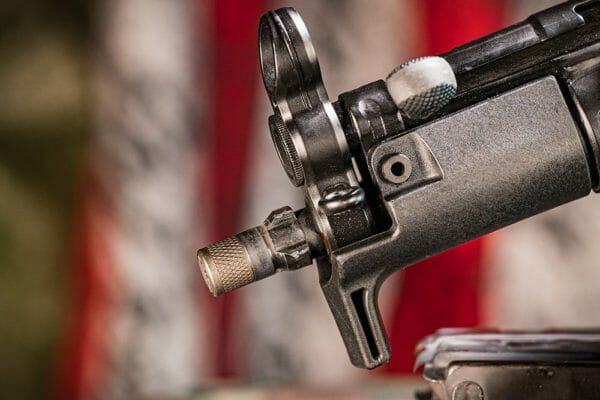
As I wrote earlier, the AP5 P features a 5.8-inch barrel with a muzzle threaded to 1/2×28. Atop this barrel, the AP5 P Core uses the iconic MP5 hooded front sight post, which is part of a housing that wraps around both the barrel and the cocking tube. Just behind the front sight, the AP5 P Core features a very compact polymer handguard with an integral handstop that is retained by a simple push-pin in the front and a lip in the trunnion at the rear. While this setup prevents the possibility of a free-floated handguard, it has the advantage of being incredibly easy and fast to swap out. No tools are required other than a thumb and one opposing finger.
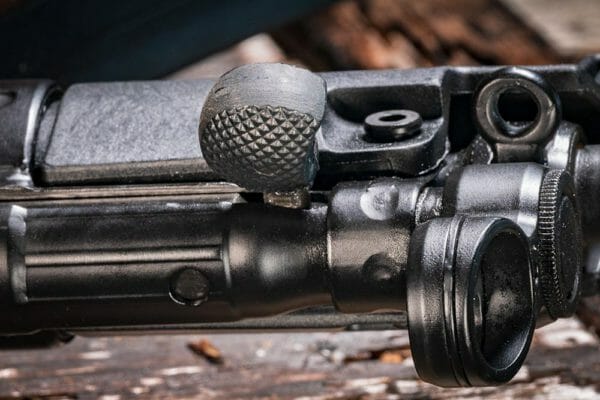
Above the handguard is the iconic cocking tube and charging handle. While the tube is virtually identical to a legit HK, the charging handle is a little different. Both are made from injection-molded polymer, but a genuine HK handle features a smooth frame around cross-checkering, while the MKE version’s checkering extends all the way to the edges. Functionally, this means nothing, and if a shooter really wants to replace it with an HK version, doing so is fairly easy and will only run about $20 at the time of this article.
Further back, the top of the receiver features guide rails, and two proper recoil stops for utilizing an HK claw mount, but unlike the previous, more expensive models offered by Century Arms, it doesn’t include one in the box. This might sound frustrating, but truth be told, the included mount wasn’t anything special, and there are far better options available on the market, like those from Midwest Industries, or my favorite, the MFI Low Profile Scope Mount. According to purists, this might ‘ruin’ the aesthetic of the MP5, but I’m not a collector, and if I’m going to utilize a firearm for home defense, I’m going to mount an optic and a flashlight on it.
Continuing downward, the AP5 P Core utilizes a combination of push-button and ambidextrous paddle magazine release. But unless your name is Dikembe Mutombo, the push button release is entirely too far from the shooting hand to feasibly reach. Thankfully, the paddle works great and is very positive.

Further back, the grip module is built from the same polymer and features a two-position safety marked, “0” for safe and “1” for semi-automatic. There’s a dimple for the safety to rotate to the bottom full-auto position, but the selector won’t budge past semi-automatic. If shooters want to install a SEF-marked lower, this can be accomplished easily. Just make sure it’s designed for “K” models. The pistol grip on the AP5 P Core features a thumb rest and finger groves for better weapon retention.
Above this, the AP5 P Core’s rear sight is the castle-style associated with compact MP5K models. For the uninitiated, this means that the rear sight drum features four notches instead of apertures and a notch.

Which, given the MP5K’s original intended close-range use, makes sense. If a shooter wants to replace it with a diopter drum, the AP5 P Core is compatible with all HK MP5 rear sights. One word of caution – when removing the original sight, do so with a blanket or a trash bag over the housing. There is a tiny spring inside, which is under tremendous pressure – you will almost certainly send it flying if you’re not careful.
Finally, the rear of the AP5 P Core is covered with a polymer end cap that features a sling swivel. Though in testing, I utilized both a single-point sling attached to that mount as well as an SB Tactical MP5K stabilizing brace – the brace is vastly superior. However, a tensioned sling is still certainly viable.
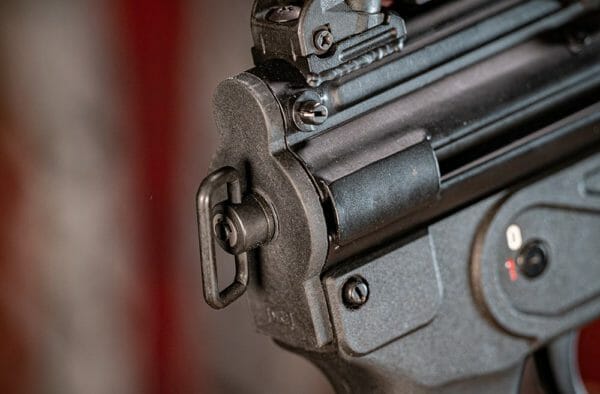
With that all out of the way, let’s get to what you’re all wondering, “Is the AP5 a good gun?”.
AP5 P Core Performance
According to the user’s manual, the AP5 P Core requires a 500-round break-in period before becoming totally reliable. In testing, this was partially true. Within the first 150 rounds, I had maybe five malfunctions where the gun would either stovepipe or double-feed. After those initial rounds, I encountered no issues whatsoever across an additional 500 rounds fired. I used a wide mix of various rounds, including 115gr FMJ from Federal, Winchester, and Tula, 124gr FMJ NATO-spec rounds from MKE under the Diamond Dogs label, 135gr XTP Hornady Critical Defense/Duty rounds, 147gr JHP match grade rounds from SIG Performance Ammunition and even 165gr FMJ subsonic “stelTH” rounds from Ammo Incorporated.
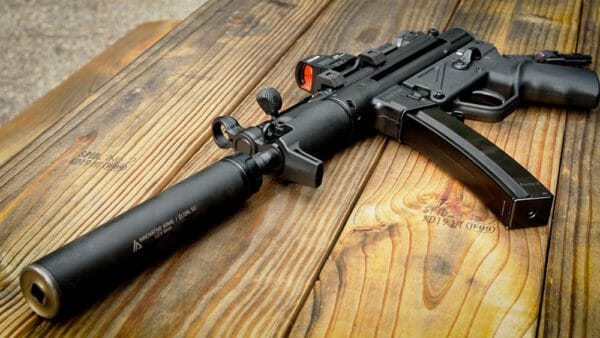
The AP5 P Core wasn’t ammunition sensitive at all, even when I ran my Innovative Arms 9mm sound suppressor and SilencerCo Osprey45 can on it.
To further test the gun’s reliability, I ran every make of MP5 magazine I had available through it. Including magazines from POF, MKE, KCI, and old pre-ban H&K mags. The Turkish pseudo sub gun ran flawlessly with every magazine tested. However, I would still like to test the Magpul drum and an original straight magazine in the future.
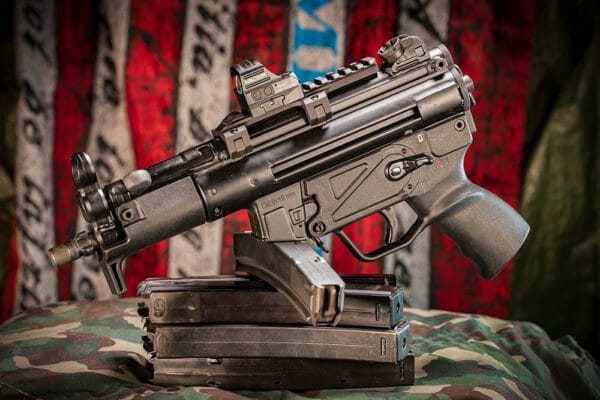
Accuracy from the Turkish MP5K clone was great too. When running my Holosun HS507C X2 micro red dot, I could easily hit a six-inch steel challenge swinger target at 50 yards. And if a shooter compensates for drop, targets out to 100 yards are surprisingly easy to hit – even if the weapon’s ballistic efficacy is somewhat diminished at that range.
As for more scientific accuracy testing, I placed the AP5 P Core on a Lyman Match Shooting Bag & Bag Jack Combo Kit, mounted a four-power Trijicon ACOG LED on it, and fired for groups. I repeatedly produced 1.5-inch groups at 50 yards with SIG’s match ammo with this setup. At the same time, standard factory ammo grouped around 2 inches at the same distance.
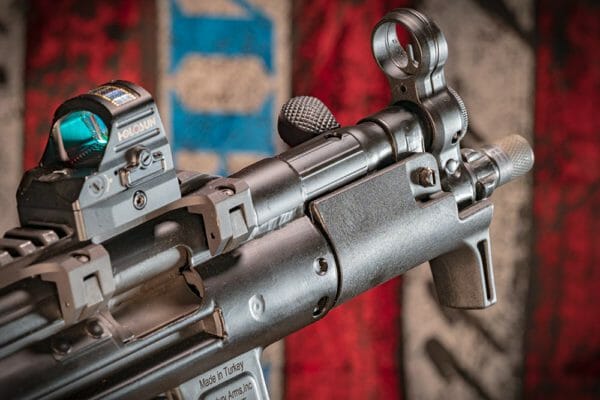
That said, there are a few small things about the MKE-made AP5 P Core that I’m not thrilled with. For starters, the gun cannot accept a full-auto sear pack, so shooters with a registered drop-in auto sear (RDIAS) either have to look elsewhere or have a gunsmith remove the block in the receiver if they want to use this gun as a host.
Secondly, the handguard on this MP5K clone gets hot very fast. More accurately, the trunnion gets hot fast, and since the stock handguard doesn’t cover said trunnion, the shooter’s support hand is going to have to deal with a lot of that heat. That said, overall still a very solid option – the pros greatly outweigh the cons. But I do have some bad news if you’re wondering, “is the AP5 legal in California?” The answer is no. And currently, I don’t believe there are any ways of modifying it to make it so. Though that could obviously change in the future.
Century Arms AP5 P Core Pistol Verdict
With an MSRP of around $1,100, the Century Arms AP5 P Core is a game-changer; it has never been cheaper or easier to get into the world of MP5s. Sure, it may lack the provenance and collectibility of a genuine Heckler and Koch, but with an MSRP around a third of a legit SP89, shooters won’t care. Especially if they’ve been on the fence about getting into the MP5s, but the cost was the biggest barrier to entry.
So to answer the question, “is the Century Arms AP5 worth it?”
Yes. Absolutely.
Product Seen in this Gun Reviews
- Century Arms AP5 P Core Pistol
- UPC: 787450829565
- MODEL: HG6035A-N
- MANUFACTURER: Century Arms
- Century Arms 9mm AP5 MP5-Clone 30-Round Magazine
- Holosun HS507C X2 Micro Red Dot
- Lyman Match Shooting Bag & Bag Jack Combo Kit
- Ammo Inc Signature 9mm 124 Grain Ammo
About Jim Grant
Jim is one of the elite editors for AmmoLand.com, who can wield a camera with expert finesse in addition to his mastery of prose. He loves anything and everything guns but holds firearms from the Cold War in a special place in his heart.
When he’s not reviewing guns or shooting for fun and competition, Jim can be found hiking and hunting with his wife Kimberly and their dog Peanut in the South Carolina low country.

Product Reviews:
“In a nutshell, the AP5 P Core Pistol is the reliable, affordable MP5K clone for which the masses have been clamoring.” ~ Jim Grant August 26th, 2022. How would you rate the Century Arms AP5 P Core Pistol?





What is the weight, barrel length and overall length?